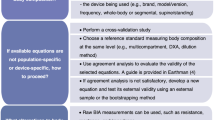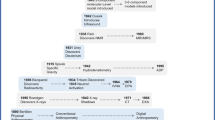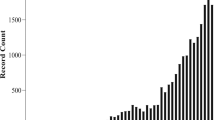Abstract
Background/Objectives:
There is wide variability in the shape and size of an individual and their body composition. This partly reflects inherent genetic differences, but to a large extent is determined by the extent to which their intake of energy and nutrients has adequately matched their needs over extended periods of time.
Subjects/Methods:
During childhood, the effective partitioning of nutrients to tissues reflects the hierarchy of demand for growth and maturation during critical periods of development. At all ages, the structural relationships at the molecular, cellular, tissue and whole-body levels are indicative of functional capability and the capacity to cope with internal and external stresses.
Results:
Reliable measurements of body composition and their interpretation can mark health, be indicative of the risk of ill-health and be a direct cause of pathology and disease. The bioeletrical impedance of the body has been used as an indirect measure for body composition, because it is a reflection of both its structural and functional characteristics, but the specifics of the relationships between these considerations still need to be determined.
Conclusions:
The measurement of bioelectrical impedance is simple to carry out and is non-invasive. It could be further refined and developed to fully explore and exploit its potential utility in practice.
This is a preview of subscription content, access via your institution
Access options
Subscribe to this journal
Receive 12 print issues and online access
$259.00 per year
only $21.58 per issue
Buy this article
- Purchase on Springer Link
- Instant access to full article PDF
Prices may be subject to local taxes which are calculated during checkout
Similar content being viewed by others
References
Prospective Studies Collaboration. Body-mass index and cause-specific mortality in 900 000 adults: collaborative analyses of 57 prospective studies. Lancet 2009; 373: 1083–1096.
Tanner J Foetus Into Man: Physiological Growth from Conception to Maturity. Open Books: London, 1978.
Widdowson EM . Harmony of growth. Lancet 1970; 1: 902–905.
Karlberg J, Jalil F, Lam B, Low L . Linear growth retardation in relation to the three phases of growth. Eur J Clin Nutr 1994; 48 (Suppl 1), S25–S43.
Jackson AA, Wootton S . Energy requirements for growth and catch-up growth. In: Schurch B, Scrimshaw NS (eds). Activity, Energy Expenditure and Energy Requirements of Infants and Children. International Dietary Energy Consultative Group: Lausanne, 1989, I/D/E/C/G.
Uauy R, Alvear J . Effects of protein-energy interactions on growth. In: Scrimshaw NS, Schurch B (eds) Protein-Energy Interactions. International Dietary Energy Consultative Group: Lausanne, Switzerland, 1992, pp 151–182.
Pond CM . An evolutionary and functional view of mammalian adipose tissue. Proc Nutr Soc 1992; 51: 367–377.
de Onis M, Onyango AW, Borghi E, Siyam A, Nishida C, Siekmann J . Development of a WHO growth reference for school-aged children and adolescents. Bull World Health Organ 2007; 85: 660–667.
WHO Multicentre Growth Reference Study Group. Relationship between physical growth and motor development in the WHO Child Growth Standards. Acta Paediatr Suppl 2006; 450: 96–101.
Borghi E, de Onis M, Garza C, Van den Broeck J, Frongillo EA, Grummer-Strawn L et al. Construction of the World Health Organization child growth standards: selection of methods for attained growth curves. Stat Med 2006; 25: 247–265.
Onis M . Relationship between physical growth and motor development in the WHO Child Growth Standards. Acta Paediatr 2006; 95: 96–101.
Waterlow JC . Note on the assessment and classification of protein-energy malnutrition in children. Lancet 1973; 302: 87–89.
Jackson AA, Picou DIM, Reeds PJ . The energy cost of repleting tissue deficits during recovery from protein-energy malnutrition. Am J Clin Nutr 1977; 30: 1514–1517.
Ashworth A . Treatment of Severe Malnutrition. J Pediatr Gastroenterol Nutr 2001; 32: 516.
Black RE, Allen LH, Bhutta ZA, Caulfield LE, de Onis M, Ezzati M et al. Maternal and child undernutrition: global and regional exposures and health consequences. Lancet 2008; 371: 243–260.
Rice A, Sacco L, Hyder A, Black R . Malnutrition as an underlying cause of childhood deaths associated with infectious diseases in developing countries. Bull World Health Organ 2000; 78: 1207–1221.
Maitland K, Berkley JA, Shebbe M, Peshu N, English M, Newton CR . Children with severe malnutrition: can those at highest risk of death be identified with the WHO protocol? PLoS Med 2006; 3: e500.
Ashworth A, Jackson A, Khanum S, Schofield C . Ten steps to recovery. Child Health Dialogue 1996; 3–4: 10–12.
Scrimshaw NS, Taylor CE, Gordon JE Interactions of Nutrition and Infection. World Health Organization: Geneva, 1968.
Calder PC, Jackson AA . Undernutrition, infection and immune function. Nutr Res Rev 2000; 13: 3–29.
General Assembly of the United Nations. United Nations Mellennium Declaration 2000 1–9. at <http://www.un.org/millennium/declaration/ares552e.pdf>.
United Nations Development Programme. What will it take to achieve the Millennium Development Goals?. UNDP 2010; 1–68. (http://content.undp.org/go/cms-service/stream/asset/?asset_id=2620072).
Lutter CK, Chaparro CM, Muñoz S . Progress towards Millennium Development Goal 1 in Latin America and the Caribbean: the importance of the choice of indicator for undernutrition. Bull World Health Organ 2011; 89: 22–30.
Waterlow JC . Introduction. Causes and mechanisms of linear growth retardation (stunting). Eur J Clin Nutr 1994; 48 (Suppl 1), S1–S4.
Fogel R, Floud R, Harris B The Changing Body: Health, Nutrition, and Human Development in the Western world since 1970. Cambridge University Press: Cambridge, 2009.
Pronyk PM, Muniz M, Nemser B, Somers MA, McClellan L, Palm CA . The effect of an integrated multisector model for achieving the Millennium Development Goals and improving child survival in rural sub-Saharan Africa: a non-randomised controlled assessment. Lancet 2012; 379: 2179–2188.
Standing Committee on Nutrition of the United Nations. 6th Report on world nutrition situation 2010; 2010: 1–134.
Department for International Development The neglected crisis of undernutrition: evidence for action DFID 2009; 1–71. (http://www.parliament.uk/deposits/depositedpapers/2010/DEP2010-0651.pdf).
Wootton S, Jackson AA Influence of Under-Nutrition in Early Life on Growth, Body Composition and Metabolic Competence. Long-term consequences of early environment: growth, development and the lifespan developmental perspective. Series: Society for the Study of Human Biology Symposium Series (No. 37) Henry CJK, Ulijaszek SJ (eds) 1996. Cambridge University Press: Cambridge.
Martorell R . Child growth retardation: a discussion of its causes and its relationship to health. In: Blaxter K, Waterlow JC (eds) Nutritional Adaptation in Man. John Libbey: London, 1985, pp 13–29.
Cole TJ . The secular trend in human physical growth: a biological view. Econ Hum Biol 2003; 1: 161–168.
Larnkjær A, Attrup Schrøder S, Maria Schmidt I, Hørby Jørgensen M, Fleischer Michaelsen K . Secular change in adult stature has come to a halt in northern Europe and Italy. Acta Paediatr 2006; 95: 754–755.
de Onis M, Blössner M, Borghi E . Prevalence and trends of stunting among pre-school children, 1990–2020. Public Health Nutr 2011; 15: 142–148.
Grantham-McGregor S, Cheung YB, Cueto S, Glewwe P, Richter L, Strupp B, International Child Development Steering Group. Developmental potential in the first 5 years for children in developing countries. Lancet 2007; 369: 60–70.
Walker SP, Wachs TD, Grantham-McGregor S, Black MM, Nelson CA, Huffman SL . Inequality in early childhood: risk and protective factors for early child development. Lancet 2011; 378: 1325–1338.
Victora CG, Adair L, Fall C, Hallal PC, Martorell R, Richter L et al. Maternal and child undernutrition: consequences for adult health and human capital. Lancet 2008; 371: 340–357.
Martorell R, Horta BL, Adair LS, Stein AD, Richter L, Fall CH et al. Weight gain in the first two years of life is an important predictor of schooling outcomes in pooled analyses from five birth cohorts from low- and middle-income countries. J Nutr 2010; 140: 348–354.
Popkin BM, Richards MK, Montiero CA . Stunting is associated with overweight in children of four nations that are undergoing the nutrition transition. J Nutr 1996; 126: 3009–3016.
Kain J, Corvalán C, Lera L, Galván M, Uauy R . Accelerated growth in early life and obesity in preschool chilean children. Obesity 2009; 17: 1603–1608.
de Onis M, Blossner M, Borghi E, Frongillo EA, Morris R . Prevalence and trends of overweight among preschool children in developing countries. Am J Clin Nutr 2000; 72: 1032–1039.
de Onis M, Blossner MB, Borghi E . Global prevalence and trends of overweight and obesity among preschool children. Am J Clin Nutr 2010; 92: 1257–1264.
Uauy R, Corvalán C, Dangour AD . Rank prize lecture global nutrition challenges for optimal health and well-being. Proc Nutr Soc 2008; 68: 34.
Corvalan C, Uauy R, Kain J, Martorell R . Obesity indicators and cardiometabolic status in 4-y-old children. Am J Clin Nutr 2009; 91: 166–174.
TODAY Study Group, Zeitler P, Hirst K, Pyle L, Linder B, Copeland K, Arslanian S et al. A clinical trial to maintain glycemic control in youth with type 2 diabetes. N Engl J Med 2012; 366: 2247–2256.
Maalouf-Manasseh Z, Metallinos-Katsaras E, Dewey KG . Obesity in preschool children is more prevalent and identified at a younger age when WHO growth charts are used compared with CDC charts. J Nutr 2011; 141: 1154–1158.
Adu-Afarwuah S, Lartey A, Brown KH, Zlotkin S, Briend A, Dewey KG . Home fortification of complementary foods with micronutrient supplements is well accepted and has positive effects on infant iron status in Ghana. Am J Clin Nutr 2008; 87: 929–938.
Dewey KG, Hawck MG, Brown KH, Lartey A, Cohen RJ, Peerson JM . Infant weight-for-length is positively associated with subsequent linear growth across four different populations. Matern Child Nutr 2005; 1: 11–20.
Adu-Afarwuah S, Lartey A, Brown KH, Zlotkin S, Briend A, Dewey KG . Randomized comparison of 3 types of micronutrient supplements for home fortification of complementary foods in Ghana: effects on growth and motor development. Am J Clin Nutr 2007; 86: 412–420.
Ashworth A . Efficacy and effectiveness of community-based treatment of severe malnutrition. Food Nutr Bull 2006; 27: S24–S48.
Ashworth A, Ferguson E . Dietary counseling in the management of moderate malnourishment in children. Food Nutr Bull 2009; 30: S405–S433.
Young Child Nutrition Working Group. Formulation subgroup formulations for fortified complementary foods and supplements: review of successful products for improving the nutritional status of infants and young children. Food Nutr Bull 2009; 30: S239–S255.
Byers T, Sedjo RL . Does intentional weight loss reduce cancer risk? Diabetes Obes Metab 2011; 13: 1063–1072.
Seidell JC . Waist circumference and waist/hip ratio in relation to all-cause mortality, cancer and sleep apnea. Eur J Clin Nutr 2009; 64: 35–41.
Barker DJP, Eriksson JG, Forsen T, Osmond C . Fetal origins of adult disease: strength of effects and biological basis. Int J Epidemiol 2002; 31: 1235–1239.
Barker DJP, Osmond C, Kajantie E, Eriksson JG . Growth and chronic disease: findings in the Helsinki Birth Cohort. Ann Hum Biol 2009; 36: 445–458.
Barker D, Osmond C, Forsen T . Trajectories of growth among children who have coronary events as adults. N Engl J Med 2005; 353: 1802–1809.
Eriksson JG, Forsen TJ, Kajantie E, Osmond C, Barker DJP . Childhood growth and hypertension in later life. Hypertension 2007; 49: 1415–1421.
Jackson AA . Integrating the ideas of life course across cellular, individual, and population levels in cancer causation. J Nutr 2005; 135: 2927S–2933S.
Jackson AA, Burdge GC, Lillicrop KA . Diet, nutrition and modulation of genomic expression in fetal origins of adult disease. J Nutrigenet Nutrigenomics 2010; 3: 192–208.
Eriksson JG . Early growth, and coronary heart disease and type 2 diabetes: experiences from the Helsinki Birth Cohort Studies. Int J Obes Relat Metab Disord 2006; 30: S18–S22.
Forsen T, Eriksson JG, Tuomilehto J, Teramo K, Osmond C, Barker DJ . Mother’s weight in pregnancy and coronary heart disease in a cohort of finnish men: follow up study. BMJ 1997; 315: 837–840.
Yajnik CS, Fall CH, Coyaji KJ, Hirve SS, Rao S, Barker DJ et al. Neonatal anthropometry: the thin-fat Indian baby. The Pune Maternal Nutrition Study. Int J Obes Relat Metab Disord 2003; 27: 173–180.
Yajnik CS . The lifecycle effects of nutrition and body size on adult adiposity, diabetes and cardiovascular disease. Obes Rev 2002; 3: 217–224.
Shelgikar KM, Hockaday TD, Yajnik CS . Central rather than generalized obesity is related to hyperglycaemia in Asian Indian subjects. Diabet Med 1991; 8: 712–717.
McKeigue PM, Shah B, Marmot MG . Relation of central obesity and insulin resistance with high diabetes prevalence and cardiovascular risk in South Asians. Lancet 1991; 337: 382–386.
Kensara OA, Wootton SA, Phillips DI, Patel M, Jackson AA, Elia M, Hertfordshire Study Group. Fetal programming of body composition: relation between birth weight and body composition measured with dual-energy X-ray absorptiometry and anthropometric methods in older Englishmen. Am J Clin Nutr 2005; 82: 980–987.
Kensara OA, Wooton SA, Phillips DI, Patel M, Hoffman DJ, Jackson AA et al. Substrate-energy metabolism and metabolic risk factors for cardiovascular disease in relation to fetal growth and adult body composition. Am J Physiol Endocrino Metab 2006; 291: E365–E371.
Wiseman M, World Cancer Research Fund/American Institute for Cancer Research. The second expert report. Food, nutrition, physical activity, and the prevention of cancer: a global perspective. Proc Nutr Soc 2008; 67: 253–256.
MacInnis RJ, English DR, Hopper JL, Haydon AM, Gertig DM, Giles GG . Body size and composition and colon cancer risk in men. Cancer Epidemiol Biomarkers Prev 2004; 13: 553–559.
Henry CJK . Quantitative relationships between protein and energy metabolism: influence of body composition. In: Scrimshaw NS, Schurch B (eds). Protein-Energy Interactions. International Dietary Energy Consultancy Group: Lausanne, Switzerland, 1991; 191–200.
Yusuf S, Hawken S, Ounpuu S, Bautista L, Franzosi MG, Commerford P et al. Obesity and the risk of myocardial infarction in 27,000 participants from 52 countries: a case–control study. Lancet 2005; 366: 1640–1649.
World Health Organization. Technical Consultation Towards the Development of a Strategy for Promoting Optimal Foetal Development 2006 1–57. at <http://www.who.int/nutrition/publications/fetal_dev_report_EN.pdf>.
United Nations General Assembly Resolution Adopted by the General Assembly. 66/2 Political Declaration of the High-level meeting of the general assembly on the prevention and conotrol of non-communicable diseases. (A/RES/66/2) January 2012; 26 (http://www.who.int/nmh/events/un_ncd_summit2011/political_declaration_en.pdf).
Touchette H Double Burden of Malnutrition 2006 1–2.
Branca F, Nikogosian H, Lobstein T . The challenge of obesity in the European region and the strategies for response. World Health Organization: Copenhagen. Regional Office for Europe, 2007.
Caballero B . A nutrition paradox--underweight and obesity in developing countries. N Engl J Med 2005; 352: 1514–1516.
Acknowledgements
This work was supported by the National Institute for Health Research (NIHR) Biomedical Research Centre in Nutrition at University Hospital Southampton NHS Foundation Trust and University of Southampton. Publication of this article was supported by a grant from seca Gmbh & Co. KG, Hamburg, Germany.
Author information
Authors and Affiliations
Corresponding author
Ethics declarations
Competing interests
The authors declare no conflict of interest.
Rights and permissions
About this article
Cite this article
Jackson, A., Johnson, M., Durkin, K. et al. Body composition assessment in nutrition research: value of BIA technology. Eur J Clin Nutr 67 (Suppl 1), S71–S78 (2013). https://doi.org/10.1038/ejcn.2012.167
Published:
Issue Date:
DOI: https://doi.org/10.1038/ejcn.2012.167
Keywords
This article is cited by
-
Association between classic and specific bioimpedance vector analysis and sarcopenia in older adults: a cross-sectional study
BMC Sports Science, Medicine and Rehabilitation (2022)
-
Bioelectrical impedance analysis for body composition assessment: reflections on accuracy, clinical utility, and standardisation
European Journal of Clinical Nutrition (2019)
-
Human body composition: yesterday, today, and tomorrow
European Journal of Clinical Nutrition (2018)
-
Development and validation of bioelectrical impedance analysis equations for predicting total body water and fat-free mass in North-African adults
European Journal of Clinical Nutrition (2013)



